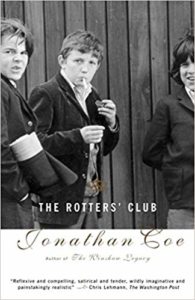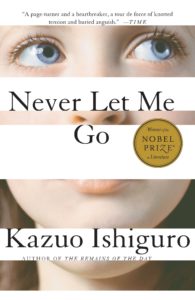I’m fascinated by friendship groups, and have always been drawn to stories where friends bring out the worst in each other—whether it’s a relatively harmless dare, a minor crime, or even murder. You can’t choose your family, but you can choose your friends—and choices always reveal something about their maker. When together, a person’s friends can create a sort of Cubist reflection of them as true as any mirror image, a reflection that can be unsettling to glimpse. Watching a character—or characters—get that glimpse in the pages of a book though, is my idea of a good time.
Fiction is a great medium to explore the many, and sometimes troubling, reasons we are drawn to others. What follows is a list of seven books that I think capture some of the darker aspects of tight-knit friendship groups.

A Fatal Inversion, by Barbara Vine
The impact of shared secrets and misunderstandings so intrigued Ruth Rendell she wrote a series of psychological thrillers under the name of Barbara Vine that explored these very themes. Vine’s A Fatal Inversion is a fascinating look at group dynamics over time and features a gang of friends haunted by a crime from their youth. It has a pet cemetery, a spooky old house, and an unidentified dead body. It’s a sad and thoughtful book that shows the damaging impact of keeping secrets. If you need a further recommendation it was shortlisted for the Dagger of Daggers, selected from the CWA Gold Dagger winners from the first 50 years of the award.

The Secret History, by Donna Tartt
In a list about tight knit groups, it would be remiss of me not to include this ingenious tale about a group of over-achieving students whose brilliance ultimately leads them to murder. Perfectly capturing the pressures and intensity of university life, the story takes some wild twists and turns that always feel believable in the context of the book thanks to Tartt’s skilled writing. It captures something very real about being young and the thrill of discovering your powers for the first time, and how without the discipline that often comes with age and experience, such powers can take you to grim places.

Dear Mr. M, by Herman Koch (translation by Sam Garrett)
A clever novel that ranks as one of my favourites of the last few years, the book marries two seemingly independent stories that end up merging in all sorts of interesting ways. The primary story concerns the life of a writer, whose most successful novel was a barely disguised retelling of a real-life mystery involving a group of school friends and the disappearance of their teacher. The actual events form the secondary story, and cast a new light on the writer’s original “novelised” version of the story. It’s both a meta-fictional crime novel and sad coming-of-age story, and while I’m not a big fan of mentioning a twist as a selling point, the book’s ending is surprising and cathartic, and justifies every narrative decision made in the previous pages.
Dare Me, by Megan Abbott
While you can choose your friends, that choice can often be limited by your situation—especially when you are young. Dare Me is a haunting and immersive tale about a very particular group of friends: a high school cheerleading squad. Tense and tight and driven by character, this book follows one squad’s finely balanced dynamic being thrown by the arrival of a new coach. It bottles the intense seriousness and claustrophobia of being young perfectly.

It, by Stephen King
King’s “final exam on horror” finds a group of friends returning home to fight their literal and figurative childhood monsters. It’s a book I read every few years and always find new things to admire. That is partly due to the dual timeline, which give the book the uncanny knack of managing to speak to you no matter what age you read it. It is also due to one of the central characters being the town itself, which allows for lots of small but incredibly well fleshed-out subplots about the supporting cast. Plenty has been written elsewhere about this book, but two lesser known and sinister parts don’t involve a shape-shifting clown at all, and are really self-contained murder mysteries. One features the death of young Dorsey Corcoran, and the other involves Bowers Gang member Patrick Hockstetter. I don’t want to spoil anything, but this sort of detail is why the novel endures, and shows early flexing of the crime-writing muscles King would later develop in books like Joyland and The Outsider.

The Rotters’ Club, by Jonathan Coe
Jonathan Coe writes gently experimental books anchored in socio-political reality and is brilliant at playing with genre (sometimes doing so within the same book). He has tried his hand at murder mystery (What a Carve Up!), espionage (Expo 58) and even (in my opinion, anyway) horror (Number 11). One of his most well-known books is The Rotters’ Club, about a group of school friends coming of age during the ‘70s in Britain, a tumultuous era of visible racism, terrorism and discontented winters. The book is often comedic, which makes the darker moments that much more devastating. What stuck with me most was one of the more chilling threads concerning the disappearance of one of the characters, which casts a shadow over the whole book. And if that doesn’t intrigue you, the book apparently has the longest sentence in English literature.

Never Let Me Go, by Kazuo Ishiguro
Another book that defies categorisation, Never Let Me Go is a heartbreaking examination of the stories we tell each other to deal with knowing we will one day die. Fun, no? But if that sounds too intense, the book is for the most part a coming-of-age tale, with romance, adventures, and misunderstandings aplenty. The darkness is mostly in the background at first, hinted at as we follow three close friends at a mysterious English boarding school. It is only as we reach the conclusion that we come to understand the brutal truth lurking outside the protective cocoon of the friendship group, and in doing so come to question our own self-built realities and the horrors they conceal.





















